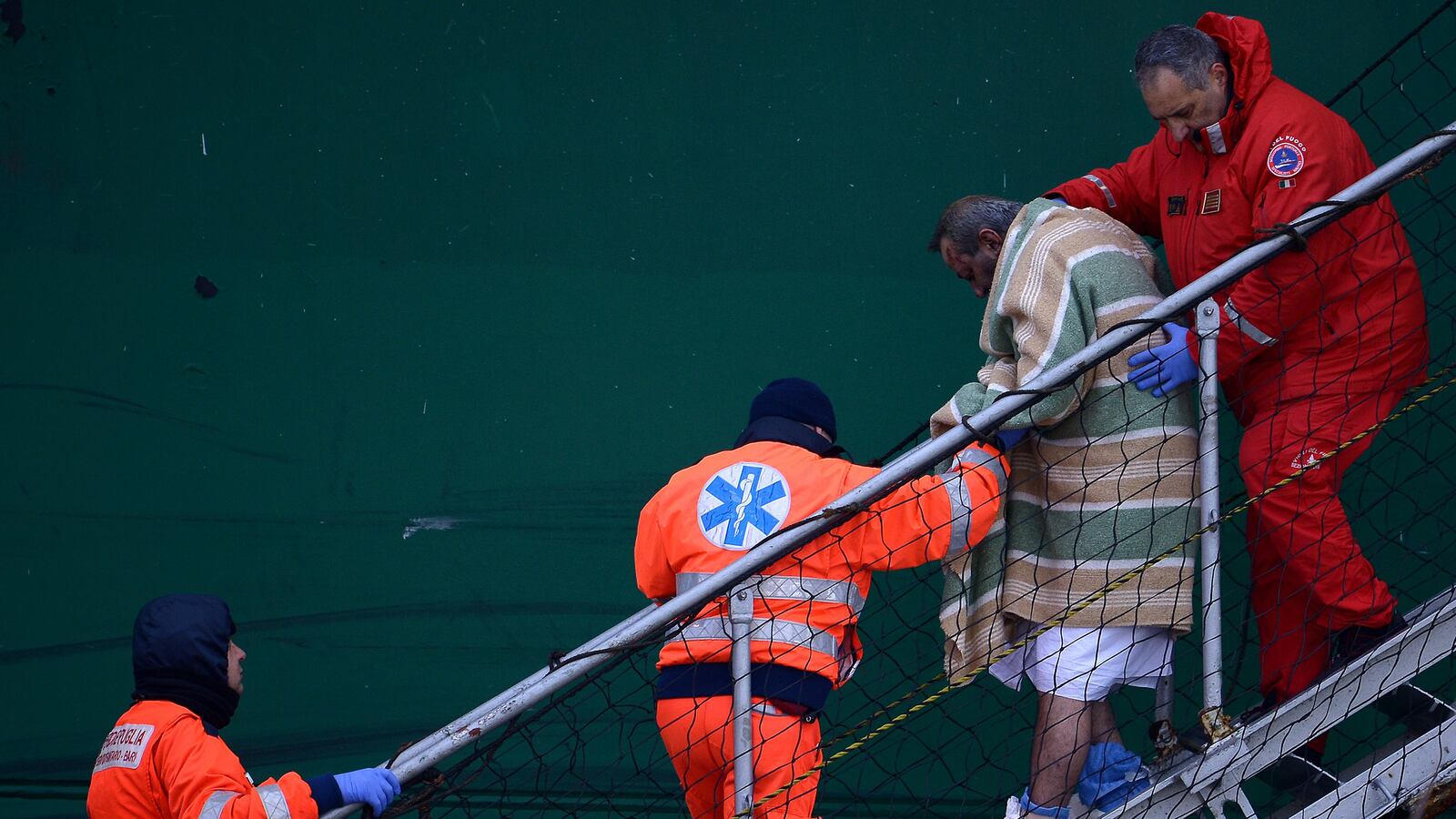ROME—When the two long whistles sounded to signal a fire aboard the Italian-flagged, Greek-run passenger ferry Norman Atlantic early Sunday morning, 56-year-old Teodora Douli and her 67-year old husband, Gheorgiu Douli, ran to the lifeboat deck. The Greek couple then started making their way down an orange rescue slide to waiting lifeboats below, according to Mrs. Douli in an interview with Italian media from her hospital bed in Lecce, Puglia.
But Mr. Douli slipped and fell into the water below and Mrs. Douli, still hung up on the orange slide, tried to save him as he bobbed in the water. “My husband and I were in the water for more than four hours,” she said, according to ANSA news service. “I tried to save him but I wasn’t able. He told me ‘We’re going to die, we’re dying.’”
Mrs. Douli then watched her husband go under water for the last time.
Mrs. Douli was eventually rescued and airlifted to a hospital on the Italian mainland, where she is being treated for fractures, hypothermia, and shock. Her husband’s remains were reportedly recovered from the sea and transported, along with 49 survivors, by merchant ship to the Italian port of Bari. But when the Douli’s son Labros, who had flown in from Greece, set about the grim task of identifying his father’s remains Monday morning, he didn’t recognize the dead man at the morgue. So far, the mystery man in the morgue has not been identified, and neither has Mr. Douli.
The confusion over the remains of the first victim is likely the tip of the iceberg in one of the most precarious maritime rescue operations ever carried out at sea as rescuers battled gale-force winds, high seas, and a blazing fire that got so hot that it burned the rubber soles of the shoes of those standing on the top deck of the ship. Passengers who called friends and relatives from the burning vessel said they were “freezing to death and suffocating from smoke,” effectively battling burning feet from below and hypothermia from above as fire boats doused the flames—along with the freezing passengers—as they tried to put out the fire.
The fire, which broke out at 4:30 a.m. Sunday morning, burned out of control for more than 15 hours before it was contained as semi trucks carrying oil canisters and flammable liquids ignited one by one in the ship’s hull. Video footage taken by a passenger showed the inferno that engulfed the ferry’s cafeteria as passengers in lifejackets wandered aimlessly around the decks nearby.
Several truck drivers who were rescued told Greek and Italian media that their vehicles were packed “like sardines” in the ship’s parking bay with many of the cabs scraping against the garage roof. Several concurred that sparks from the scraping metal could have easily set the fatal fire. Leonida Costantiniris, a Greek truck driver who woke in his cabin when he smelled smoke, described to reporters how he suffered third-degree burns on his feet. “When I saw the fire in the restaurant, I ran down to the floor below, where I was trapped between flames above and below.” He ran through the flames to safety.
The Greek transportation minister confirmed in a press conference that none of the fire-safety doors apparently worked, and neither did the emergency generator. After the captain made the call to abandon ship, 150 people were able to escape on lifeboats lowered by electronic arms. But when the ship lost power and the emergency generators failed, the lifeboats could no longer be deployed, leaving more than 300 people stranded for more than 24 hours as rescuers tried to get close enough to the drifting ship to first secure it to tug boats and then winch passengers into helicopters before shuttling them to waiting rescue ships. Helicopters lifted pregnant women and children to safety first. Many of the children suffered early signs of hypothermia.
As night fell, the rescue operation slowed and sea conditions worsened. It took 12 hours to rescue just 100 passengers overnight Sunday.
On Sunday night, Greek authorities confirmed to reporters that “there are no missing” and that all of the passengers were accounted for either on the ship or on rescue vehicles. The Italian navy tweeted regular updates of the saved-to-stranded passenger ratio. But when all of the passengers were finally off the ship on Monday afternoon, there were seven more dead who had either been unaccounted for—or who had died while the ship’s captain and crew were trying to coordinate the rescue operations. A criminal inquest has been opened to help speed up the investigation into the discrepancy and to determine just how many passengers were on the Norman Atlantic.
Among the passengers rescued but apparently not on the master list were two undocumented migrants from Afghanistan, who told authorities they stowed away in the ship’s hull and ran for safety when they smelled smoke, according to RAI television. Italian authorities, led by Prime Minister Matteo Renzi at his year-end press conference on Monday afternoon, acknowledged that the Greece-to-Italy ferries are a common corridor for migrants on the move, and that there could be other fatalities in the ship’s scorched hull once it stops burning.
That won’t be known until the ship can be safely towed to a harbor—either in Albania just 13 miles from where the rescue operation took place, or, more likely in Brindisi on the Italian mainland, where a thorough criminal investigation can be carried out.
Wherever the ferry ultimately docks, it may take months to sift through the melted cars and trucks in the charred hull to look for more victims and to try to determine just what started the icy inferno in the Adriatic.






